Geospatial Data Science Applications: GEOG 4/590
Jan 31, 2022
Lecture 5: Machine learning
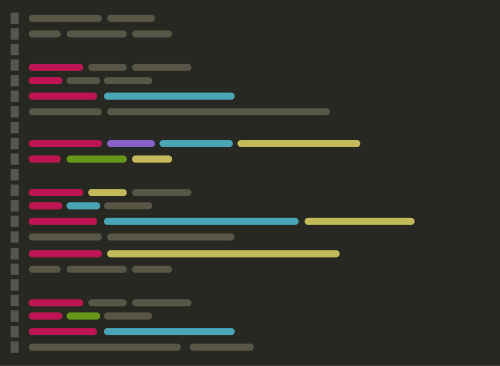
Johnny Ryan: jryan4@uoregon.edu
Content of this lecture¶
- Crash course on machine learning for environmental applications
* Introduce `scikit-learn` for machine learning in Python
* Learn how to represent data so a program can learn from it
* Learn how to evaluate a machine learning model
* Background for this week's lab
What is machine learning?¶
- The goal of machine learning is use input data to make useful predictions on never-before-seen data
- Machine learning is part of artificial intelligence, but not the only part
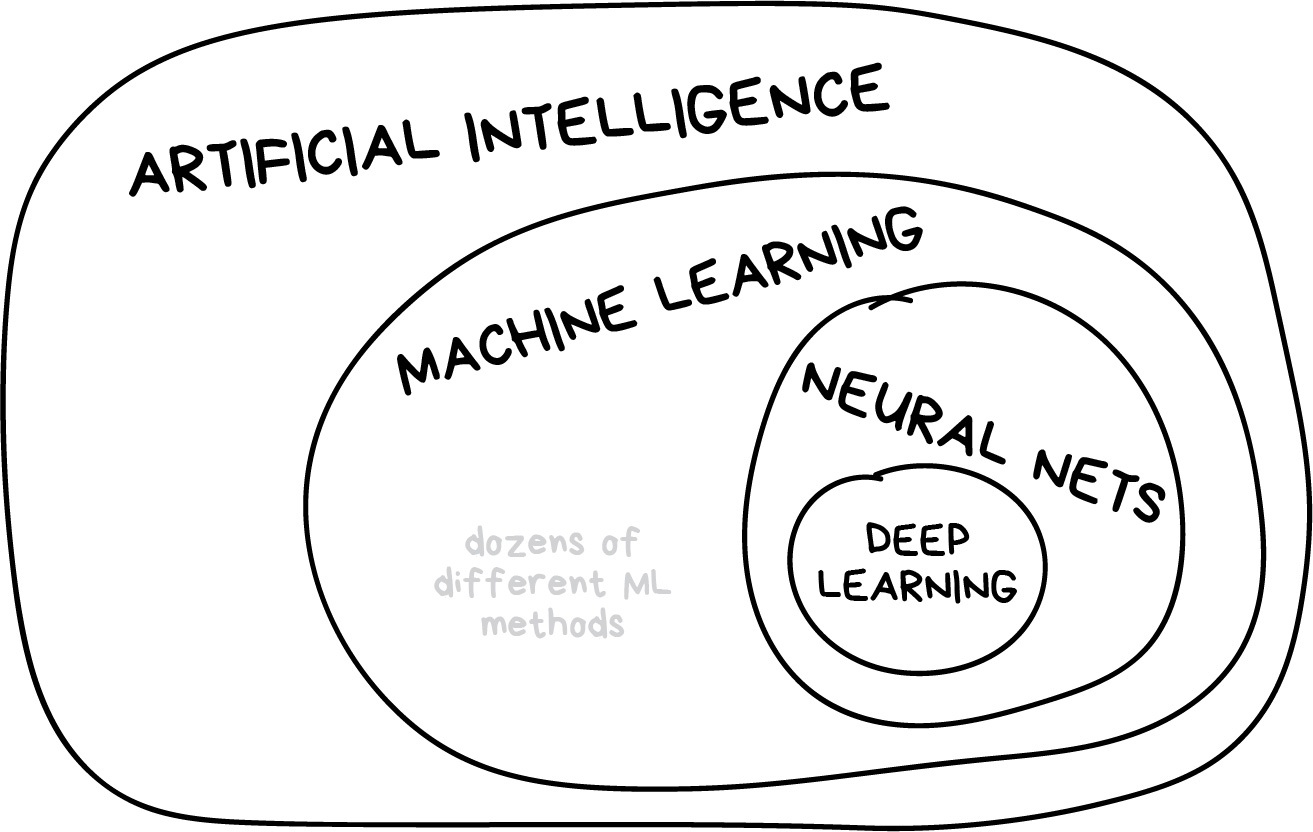
Input data¶
Machine learning starts with a labelled dataset
A label (or target variable) is the thing we're predicting (e.g.
yvariable in linear regression)For example, house price, river discharge, land cover etc.
Input data¶
It's tough to collect a good collection of data (time-consuming, expensive)
These datasets are therefore extremely valuable
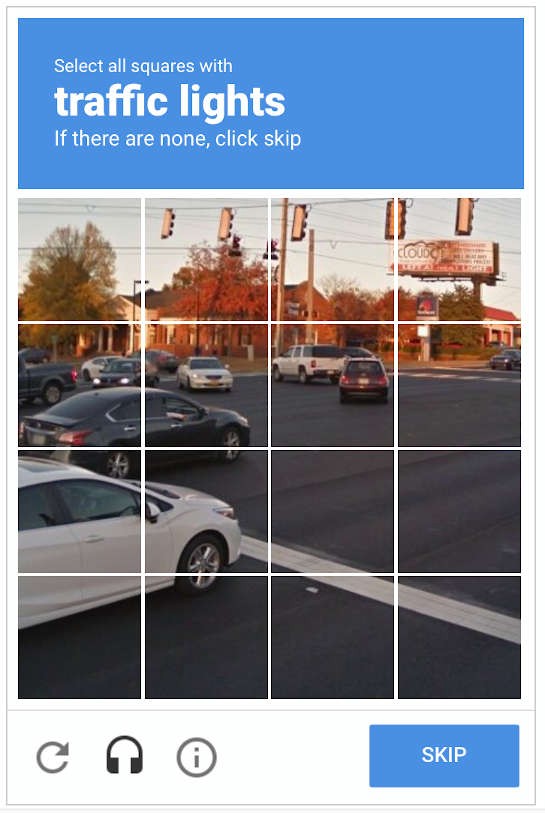
Features¶
An input variable (e.g. the
xvariable in linear regression)A simple dataset might use a one or two features while a more complex dataset could have thousands of features
In our river discharge example - features could include precipitation, snow depth, soil moisture
Algorithms¶
There are many (e.g. naive bayes, decision trees, neural network etc.)
Performance of algorithm dependent on type of problem
Just remember: garage in, garbage out

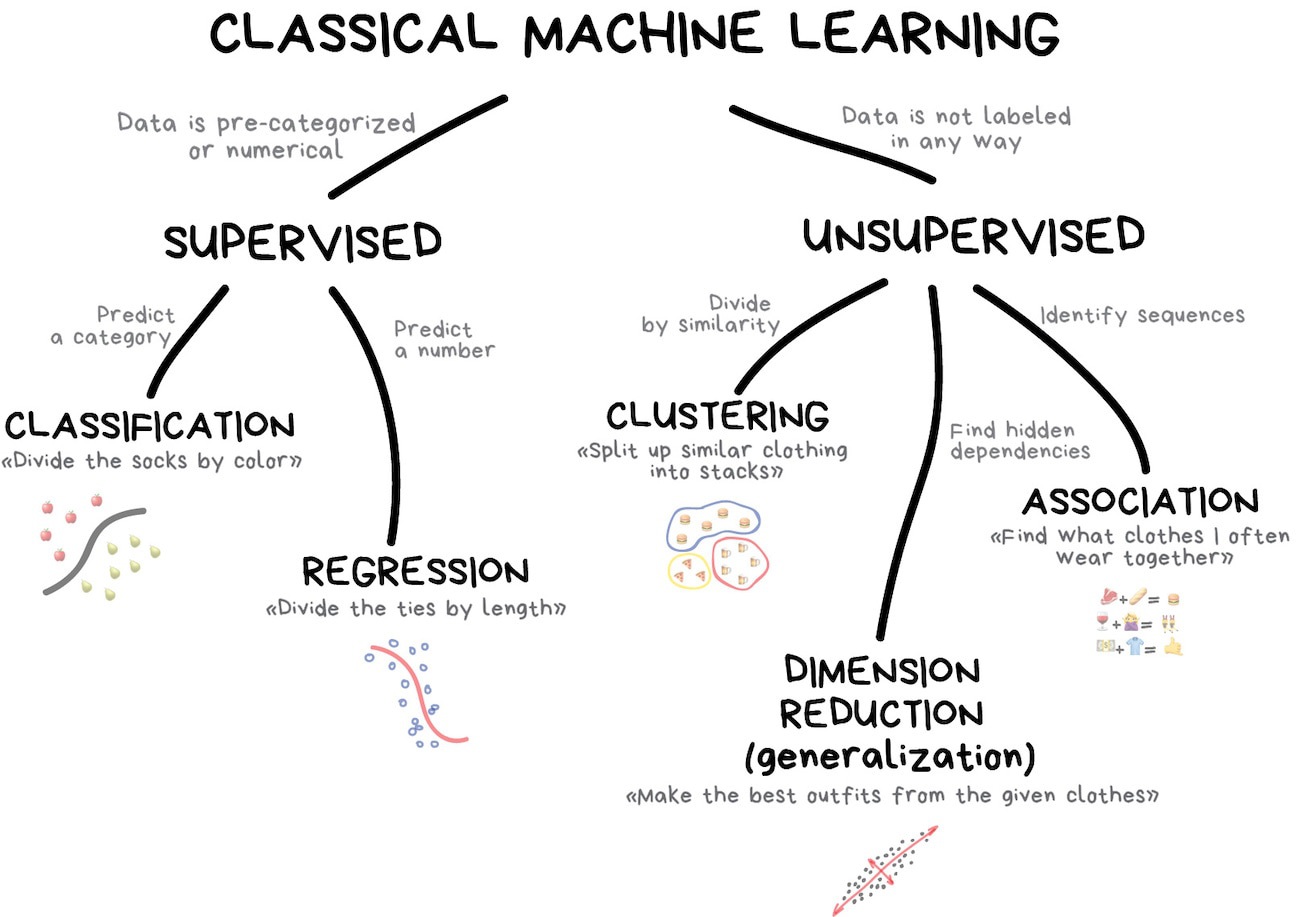
Supervised learning¶
Training data is already labeled and we teach the machine to learn from these examples
Supervised learning can used to predict a category (classification) or predict a number (regression)
Classification¶
"Split things into groups based on their features"
Examples include:
- Land cover
- Flood risk
- Sentiment analysis
Popular algorithms include:
- Naive Bayes
- Decision Trees
- K-Nearest Neighbours
- Support Vector Machine
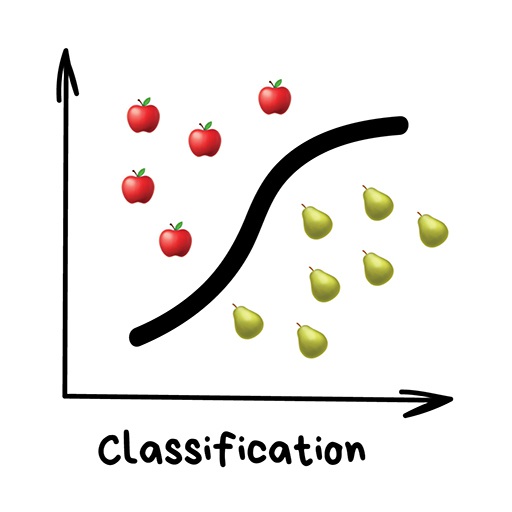
Regression¶
"Draw a line through these dots"
Used for predicting continuous variables:
- River discharge
- House prices
- Weather forecasting
Popular algorithms include linear regression, polynomial regression, + other algorithms
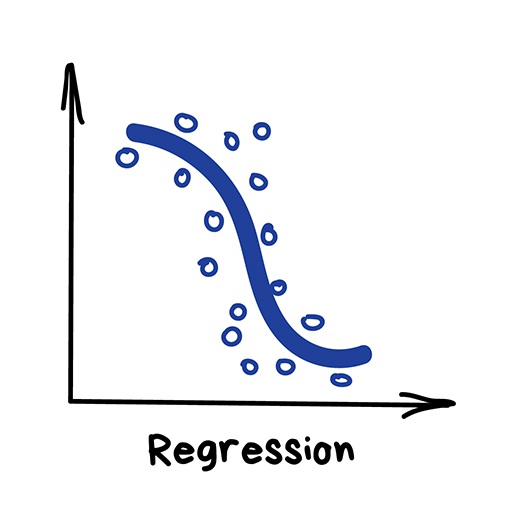
Unsupervised learning¶
Labeled data is a luxury, sometimes we don't have it
Sometimes we have no idea what the labels could be
Much less used in geospatial data science but sometimes useful for exploratory analysis
Clustering¶
"Divide data into groups but machine chooses the best way"
Common usages include:
- image compression
- labeling training data (i.e. for supervised learning)
- detecting abnormal behavior
Popular algorithms:
- K-means clustering
- Mean-Shift
- DBSCAN
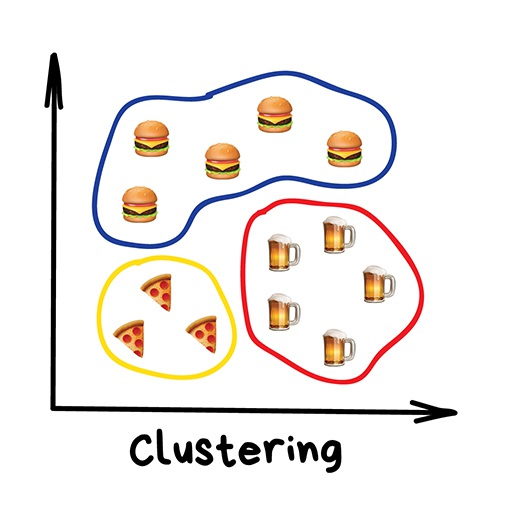
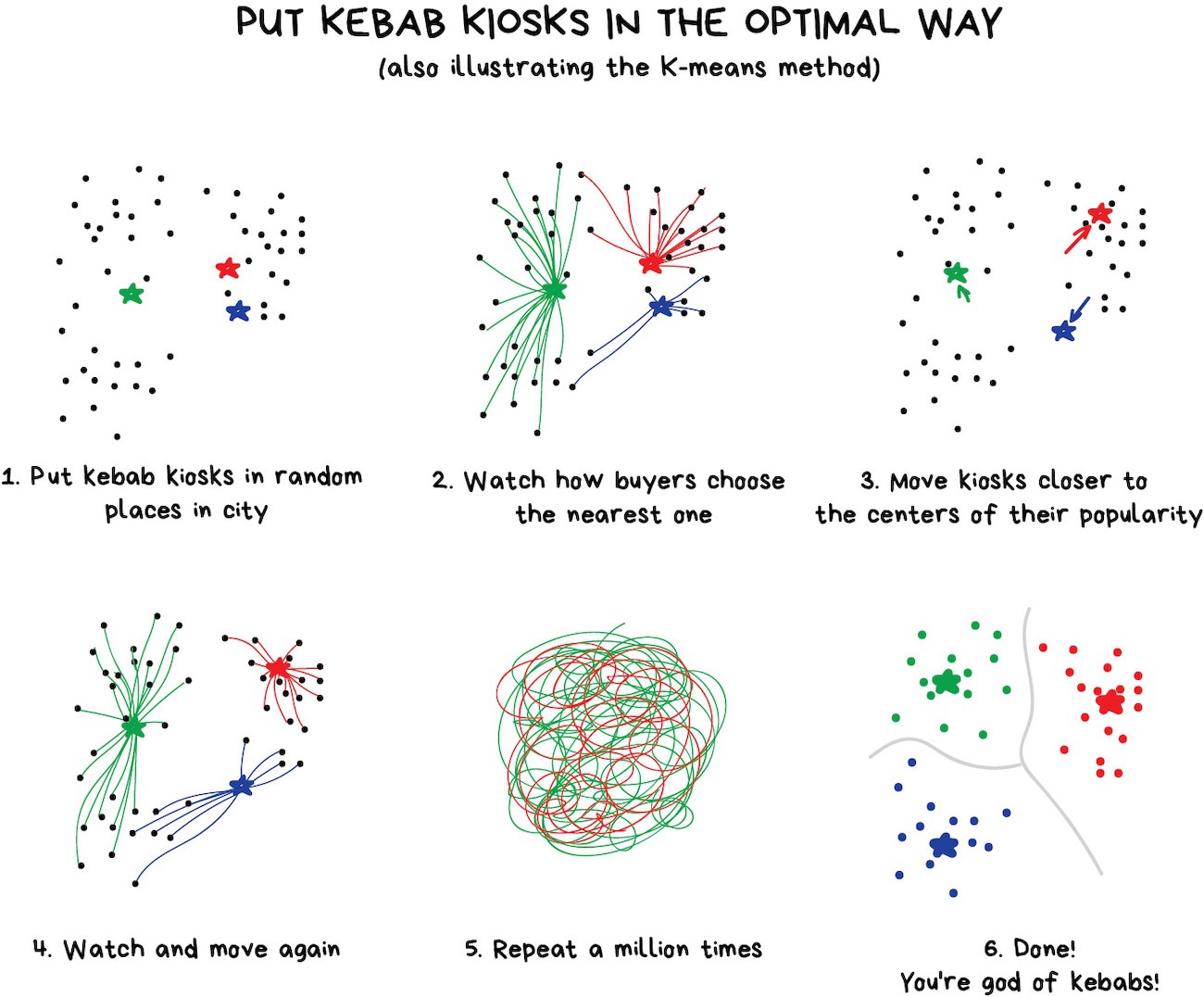
Dimensionality reduction¶
"Assemble specific features into higher-level ones"
When we have too many features, some of which are useless
Most popular algorithm is Principal Component Analysis (PCA)
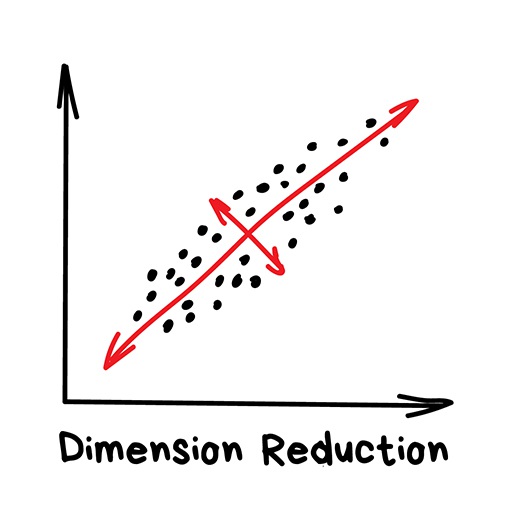
Ensemble methods¶
"Multiple learning algorithms learning to correct errors of each other"
Often used improve the accuracy over what could be acheived with a single classical machine learning model.
Popular algorithms:
- Random Forest
- XGBoost
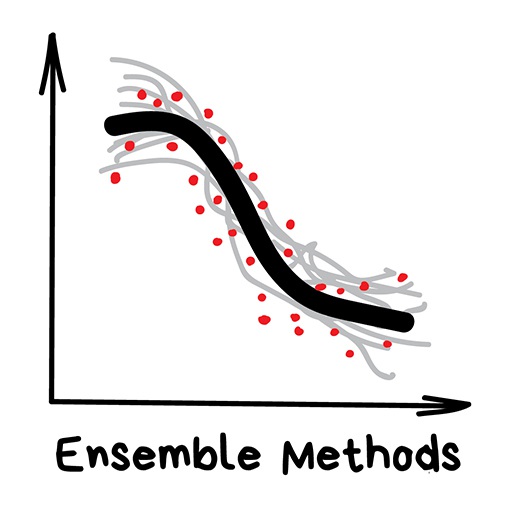
Bagging¶
- Apply the same algorithm but train it on different subsets of original data. At the end - just average the answers. Most famous example is Random Forests.
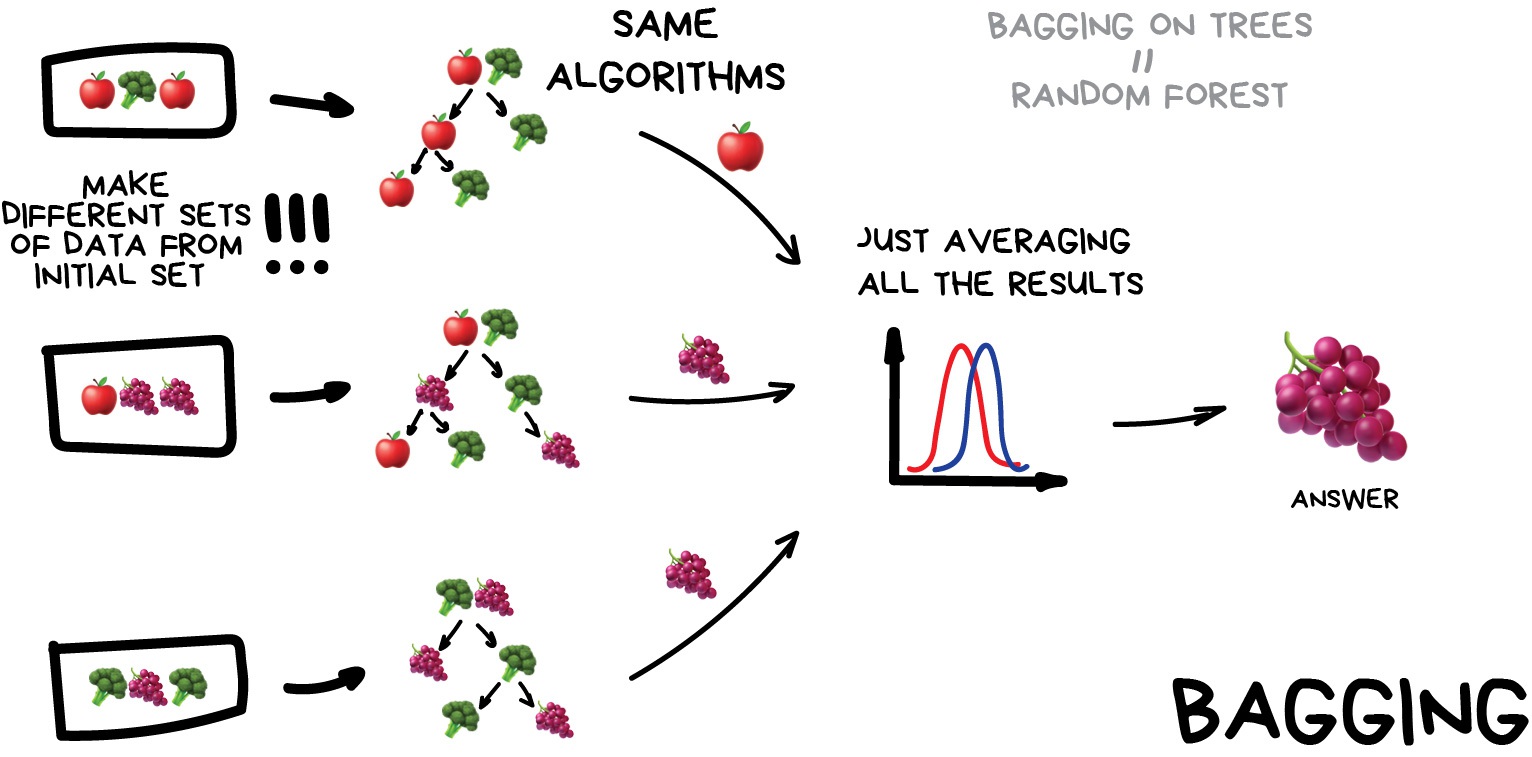
Boosting¶
Similar to bagging but each subsequent algorithm is paying most attention to data points that were mispredicted by the previous one.
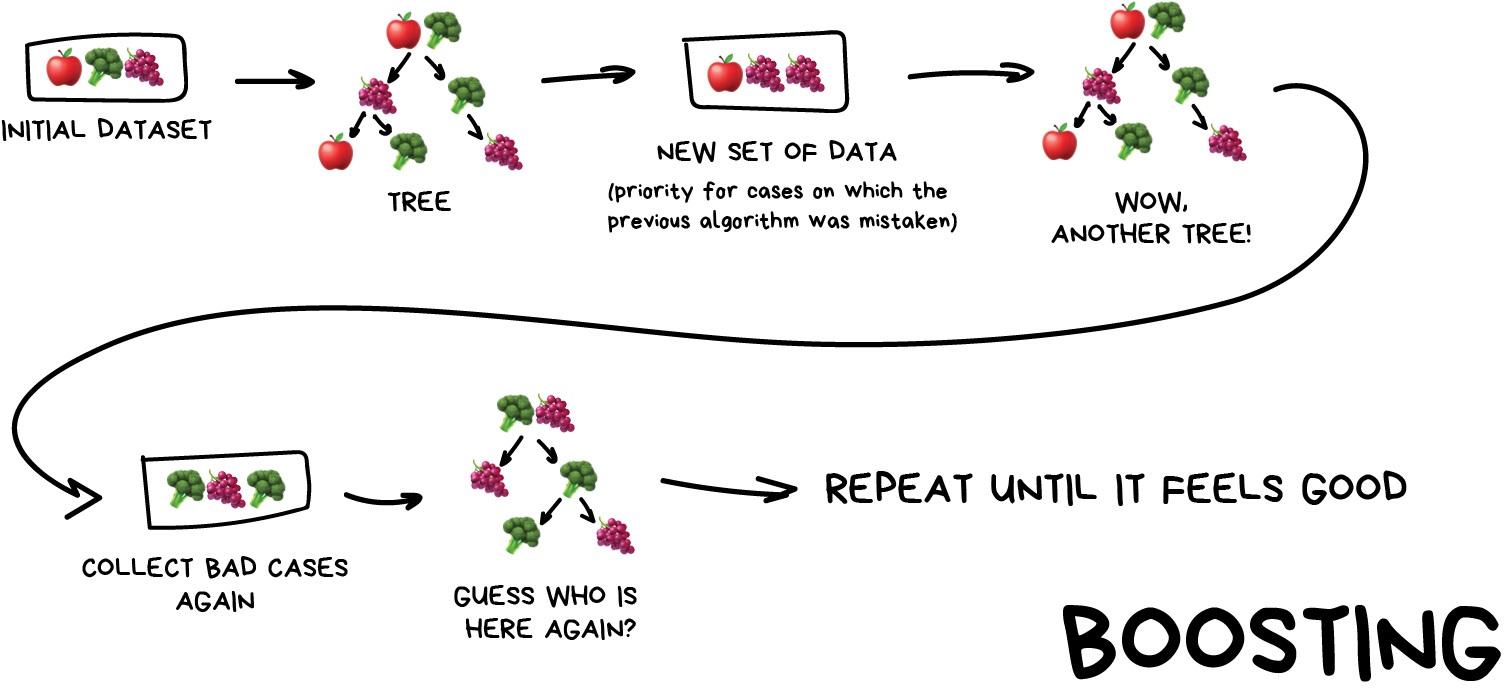
Predicting house prices using scikit-learn¶
The California house price dataset is a classic example dataset derived from the 1990 U.S. Census
Labels = house prices at the block group level (a block group typically has a population of 600 to 3,000 people)
Features = longitude, latitude, housing_median_age, total_rooms, total_bedrooms, population, households, median_income
# Import libraries
import pandas as pd
import numpy as np
import matplotlib.pyplot as plt
# Read dataset
df = pd.read_csv('data/california_house_prices.csv')
# Examine dataset (each row represents one block group)
df.head()
| housing_median_age | total_rooms | total_bedrooms | population | households | median_income | median_house_value | |
|---|---|---|---|---|---|---|---|
| 0 | 51 | 1905 | 291 | 707 | 284 | 6.2561 | 431000 |
| 1 | 51 | 1616 | 374 | 608 | 302 | 3.1932 | 400000 |
| 2 | 51 | 2413 | 431 | 1095 | 437 | 4.0089 | 357000 |
| 3 | 51 | 1502 | 243 | 586 | 231 | 4.3750 | 332400 |
| 4 | 51 | 2399 | 516 | 1160 | 514 | 3.8456 | 318900 |
Check data¶
# Check for NaN values and data types
df.info()
<class 'pandas.core.frame.DataFrame'> RangeIndex: 15267 entries, 0 to 15266 Data columns (total 7 columns): # Column Non-Null Count Dtype --- ------ -------------- ----- 0 housing_median_age 15267 non-null int64 1 total_rooms 15267 non-null int64 2 total_bedrooms 15267 non-null int64 3 population 15267 non-null int64 4 households 15267 non-null int64 5 median_income 15267 non-null float64 6 median_house_value 15267 non-null int64 dtypes: float64(1), int64(6) memory usage: 835.0 KB
Check data¶
# Check summary statistics
df.describe()
| housing_median_age | total_rooms | total_bedrooms | population | households | median_income | median_house_value | |
|---|---|---|---|---|---|---|---|
| count | 15267.000000 | 15267.000000 | 15267.000000 | 15267.000000 | 15267.000000 | 15267.00000 | 15267.000000 |
| mean | 26.924805 | 2678.617214 | 549.977075 | 1476.071199 | 510.814371 | 3.70112 | 189416.617345 |
| std | 11.426288 | 2225.565198 | 430.964703 | 1180.890618 | 393.232807 | 1.57686 | 95681.349164 |
| min | 1.000000 | 2.000000 | 2.000000 | 3.000000 | 2.000000 | 0.49990 | 14999.000000 |
| 25% | 17.000000 | 1469.000000 | 302.000000 | 814.000000 | 286.000000 | 2.53665 | 115400.000000 |
| 50% | 27.000000 | 2142.000000 | 441.000000 | 1203.000000 | 415.000000 | 3.47840 | 171200.000000 |
| 75% | 36.000000 | 3187.000000 | 661.000000 | 1780.000000 | 614.500000 | 4.62635 | 243050.000000 |
| max | 51.000000 | 37937.000000 | 6445.000000 | 35682.000000 | 6082.000000 | 15.00010 | 499100.000000 |
Visualize data¶
# Plot histogram
_ = df.hist(bins=50 , figsize=(20, 10))
Correlation analysis¶
- It is always useful to compute correlation coeffcients (e.g.Pearson's r) between the labels (i.e.
median_house_value) and features.
# Compute correlation matrix
corr_matrix = df.corr()
# Display just house value correlations
corr_matrix["median_house_value"].sort_values(ascending= False)
median_house_value 1.000000 median_income 0.668566 total_rooms 0.152923 households 0.098525 total_bedrooms 0.079023 population 0.020930 housing_median_age 0.014355 Name: median_house_value, dtype: float64
Warning¶
Just remember that correlation coefficients only measure linear correlations ("if
xgoes up, thenygenerally goes up/down").They may completely miss nonlinear relationships (e.g., "if
xis close to zero thenygenerally goes up").

Feature scaling¶
Machine Learning algorithms don’t perform well when the input numerical attributes have very different scales.
We often scale (or normalize) our features before training the model (e.g. min-max scaling or standardization).
Min-max method scales values so that they end up ranging from 0 to 1
Standardization scales values so that the they have mean of 0 and unit variance.

# Import library
from sklearn.preprocessing import StandardScaler
# Define feature list
feature_list = ['housing_median_age', 'total_rooms', 'total_bedrooms',
'population', 'households', 'median_income']
# Define features and labels
X = df[feature_list]
y = df['median_house_value']
# Standarize data
scaler = StandardScaler()
X_scaled = scaler.fit_transform(X)
Split data in training and testing subsets¶
from sklearn.model_selection import train_test_split
# Split data
X_train, X_test, y_train, y_test = train_test_split(X_scaled, y, test_size=0.2, random_state=42)
Multiple linear regression¶
A very simple supervised algorithm that fits a linear model to our data using a least squares approach.
from sklearn.linear_model import LinearRegression
# Define model
lin_reg = LinearRegression()
# Fit model to data
lin_reg.fit(X_train, y_train)
LinearRegression()
from sklearn.metrics import mean_squared_error
# Predict test labels
predictions = lin_reg.predict(X_test)
# Compute mean-squared-error
lin_mse = mean_squared_error(y_test, predictions)
lin_rmse = np.sqrt(lin_mse)
lin_rmse
64374.61617631897
# Plot
fig, ax = plt.subplots(figsize=(8, 6))
ax.scatter(y_test, predictions, alpha=0.1, s=50, zorder=2)
ax.plot([0,500000], [0, 500000], color='k', lw=1, zorder=3)
ax.set_ylabel('Predicted house price ($)', fontsize=14)
ax.set_xlabel('Observed house price ($)', fontsize=14)
ax.tick_params(axis='both', which='major', labelsize=13)
ax.grid(ls='dashed', lw=1, zorder=1)
ax.set_ylim(0,500000)
ax.set_xlim(0,500000)
(0.0, 500000.0)
Decision Tree¶
A popular machine learning algorithm that predicts a target variable using multiple regression trees
from sklearn.tree import DecisionTreeRegressor
# Define model
tree_reg = DecisionTreeRegressor()
# Fit model
tree_reg.fit(X_train, y_train)
DecisionTreeRegressor()
# Predict test labels
predictions = tree_reg.predict(X_test)
# Compute mean-squared-error
tree_mse = mean_squared_error(y_test, predictions)
tree_rmse = np.sqrt(tree_mse)
tree_rmse
82289.76594673106
# Plot
fig, ax = plt.subplots(figsize=(8, 6))
ax.scatter(y_test, predictions, alpha=0.1, s=50, zorder=2)
ax.plot([0,500000], [0, 500000], color='k', lw=1, zorder=3)
ax.set_ylabel('Predicted house price ($)', fontsize=14)
ax.set_xlabel('Observed house price ($)', fontsize=14)
ax.tick_params(axis='both', which='major', labelsize=13)
ax.grid(ls='dashed', lw=1, zorder=1)
ax.set_ylim(0,500000)
ax.set_xlim(0,500000)
(0.0, 500000.0)
RandomForests¶
A popular ensemble algorithm that fits a number of decision tree classifiers on various sub-samples of the dataset and uses averaging to improve the predictive accuracy and control over-fitting.
from sklearn.ensemble import RandomForestRegressor
# Define model
forest_reg = RandomForestRegressor(n_estimators = 30)
# Fit model
forest_reg.fit(X_train, y_train)
RandomForestRegressor(n_estimators=30)
# Predict test labels predictions
predictions = forest_reg.predict(X_test)
# Compute mean-squared-error
final_mse = mean_squared_error(y_test , predictions)
final_rmse = np.sqrt(final_mse)
final_rmse
60264.63679436083
# Plot
fig, ax = plt.subplots(figsize=(8, 6))
ax.scatter(y_test, predictions, alpha=0.1, s=50, zorder=2)
ax.plot([0,500000], [0, 500000], color='k', lw=1, zorder=3)
ax.set_ylabel('Predicted house price ($)', fontsize=14)
ax.set_xlabel('Observed house price ($)', fontsize=14)
ax.tick_params(axis='both', which='major', labelsize=13)
ax.grid(ls='dashed', lw=1, zorder=1)
ax.set_ylim(0,500000)
ax.set_xlim(0,500000)
(0.0, 500000.0)